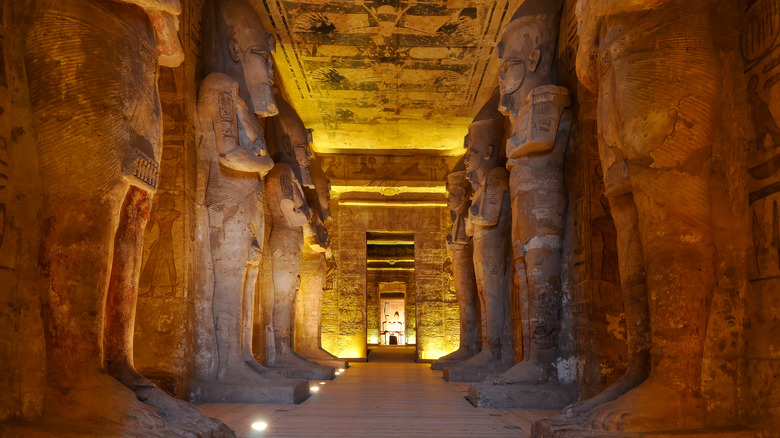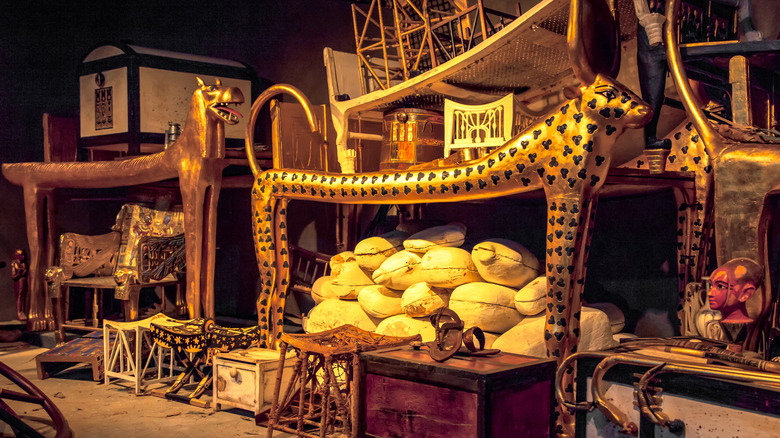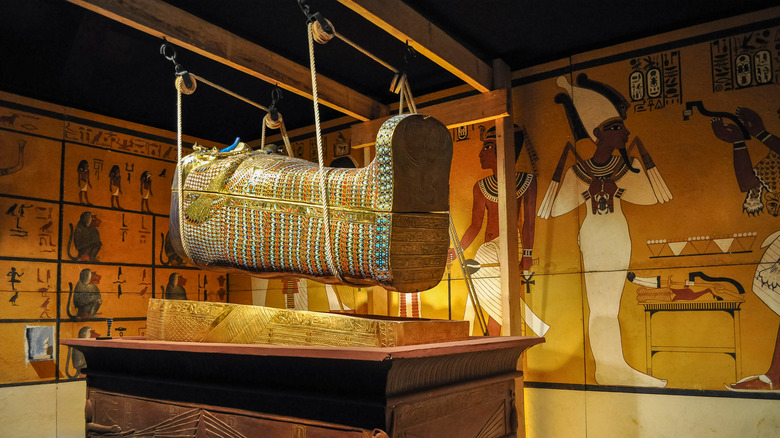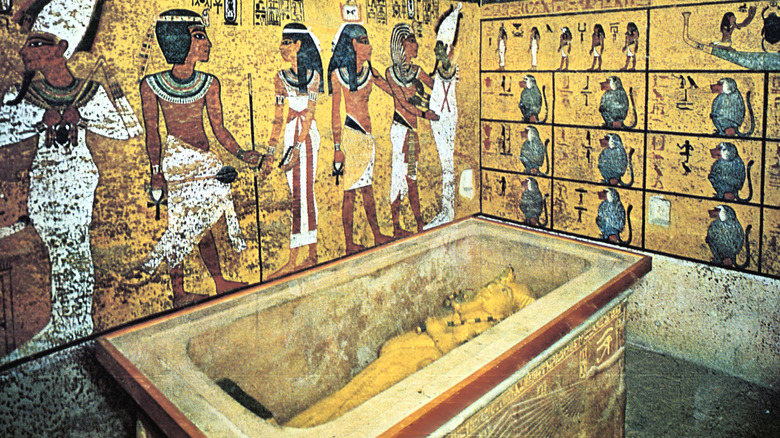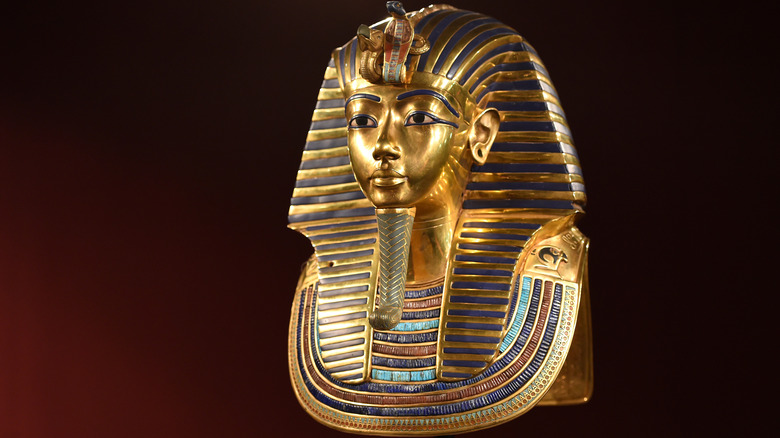King Tut's Tomb Hid A Disturbing Truth About His Children
The ancient pharaohs of Egypt lived fascinating lives, and their legacies have captivated the masses for centuries. According to National Geographic, these pharaohs served as ultimate rulers, kings of all Egyptian peoples, overseeing both law and land. While their lives have been glorified, cinematized, and encased behind museum glass as sights to behold, it could be argued that their deaths were even more impactful and the central reason behind the interest in their lives.
Egyptian tombs are at the heart of this ado. These ancient burial spaces were meticulously crafted and majestically preserved. They tell the story of the pharaohs' status, wealth, and opulence, and they tell it with just the right amount of mystery. Every nook and turn within an Egyptian tomb is like a doorway to another secret. And of all the tombs in all the legends across all the lands, the tomb of young King Tut is perhaps the most alluring of all (via World Atlas). In it lies a wealth of antiquated objects, and a disturbing truth about his children that you might not know.
King Tut's tomb provided more information than any other tomb
According to World Atlas, of all the tombs erected in the ancient Egyptian era, young King Tut's was the least robbed and, therefore, the best-preserved piece of history archeologists found. This tomb was excavated by archeologists in the Valley of the Kings more than a century ago. In it were more than 5,000 awe-inspiring objects ranging from golden chariots and coffins to elegant pieces of jewelry and clothing. It contained the much-debated gilded "dagger from outer space" (via Live Science) and the infamous gold death mask, which has haunted hearts and minds since its discovery.
These findings unlocked the secret world of ancient burial processes, clueing us in on how post-humus kings were mummified, a gruesome process that included the removal of the brain and digestive tract — yikes! It gave us a glimpse into the religious and cultural rituals that encompassed ancient Egyptian royal life and death. Each passage was a right of passage, which would have certainly sufficed in satiating the most inquisitive of historians. However, beyond the death masks, space daggers, and chariots lies perhaps an even darker truth about the children of the late King Tut.
Two tiny gilded coffins held the late pharaoh's stillborn daughters
At the time of the tomb's discovery in the historic Valley of the Kings, excavators discovered two tiny wooden boxes containing gilded coffins among the antiquated relics in the tomb. According to Promega Connections, autopsies conducted in 1925 and 1932 concluded that each coffin contained a stillborn child. Archeologists long speculated that the two tiny coffins contained the mummified remains of King Tutankhamun's daughters. The Daily Express reports that many believed their burial and mummification were part of a ritualistic process, and the daughters had been positioned as guardian for their father — the king — against demons he might encounter in the afterlife.
Professor Salima Ikram of the American University in Cairo claimed that high infant mortality rates made stillborn births rather commonplace in the ancient world; but the fact that these two tiny skeletons were meticulously mummified and placed alongside the king made their presence special, to the point of being spiritual. Later testing confirmed that they were indeed the stillborn daughters of the 19-year-old king, but that's not all they confirmed. Another shocking find was yet to come.
Abnormalities and malformities were observed in both tiny skeletons
Radiographic imagery suggests the larger coffin belonged to a nearly full-term baby whose gestational age could have been as old as 37 weeks (via Promega Connections). The smaller skeleton is believed to have exhibited a gestational age of 25 weeks. Sadly, this imagery also revealed that both mummies showed congenital abnormalities of the scapula and spine, not to mention the kind of cranial fractures and malformities that typically come as a result of incestual relations between closely related family members. Defects were observed along the feet, arms, and spine of the bigger mummy, including a dislocated clavicle and displaced shoulder on the left side.
In 1978, the question arose: Were these fractures and malformities sustained post-mortem or had they been the reason for the stillbirths in the first place? If the latter were true, did incest play a role in these infant mortalities? Today, we finally possess the technology needed to answer those questions (per the National Library of Medicine). The results are shocking, to say the least.
Forensic image analysis suggests mostly postmortem damage
According to Promega Connections, the 1978 assumption that these babies were stillborn due to skeletal abnormalities is scientifically unfounded. While Egypt's ruling class exhibited an elongated history of incest that translated to genetic disorders, forensic investigations show these two fetuses likely incurred their skeletal abnormalities after the mummification process had already taken place. According to scientists, the dislocated clavicle and displaced left shoulder shown in the larger mummy appear to have been the result of postmortem injuries. Furthermore, the smaller mummy did not appear to exhibit any skeletal abnormalities upon closer scrutiny.
History reports that DNA analysis of the late King Tut of Egypt proved he was the product of an incestual relationship, so it seemed safe to assume this as the cause of death for both of his stillborn children. Now, science has mostly ruled that option out, and the reason they did not fully develop remains an enduring mystery.
The close relation between King Tut's parents likely led to his disabilities
Unlike the bodies of his stillborn children, which sustained mainly post-mortem injuries, King Tut was born with a myriad of skeletal abnormalities that suggest his parents were closely related (via History). According to Promega Connections, the feeble ruling Pharaoh Tut was often portrayed as sitting while engaged in activities where most people stood. Forensic exams confirm this was likely because he had a clubfoot in addition to a cleft palate and multiple bone abnormalities and diseases that plagued him as a child and young adult.
A DNA study published in 2010 in the Journal of the American Medical Association and reported by Live Science claimed these deficiencies occurred because King Tut's parents were actually brother and sister. Since then, some scientists have expressed opposition, claiming the malformities took place after three successive generations of first cousins were wed and mated. Regardless of which theory is more correct, the fact remains that there was significant inbreeding taking place amongst the ruling Egyptian leaders, much to the detriment of their offspring.
